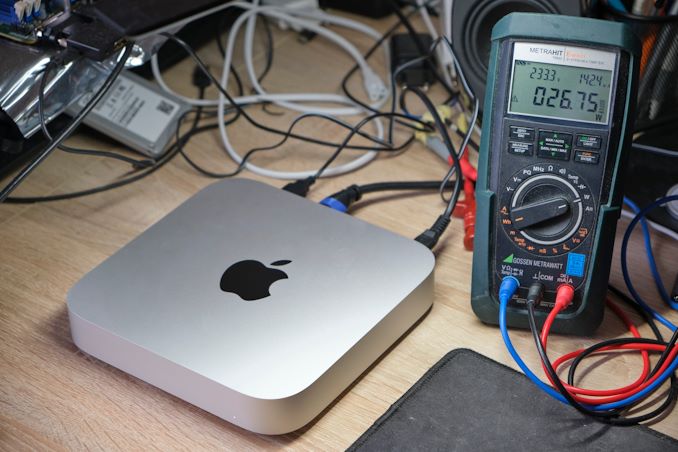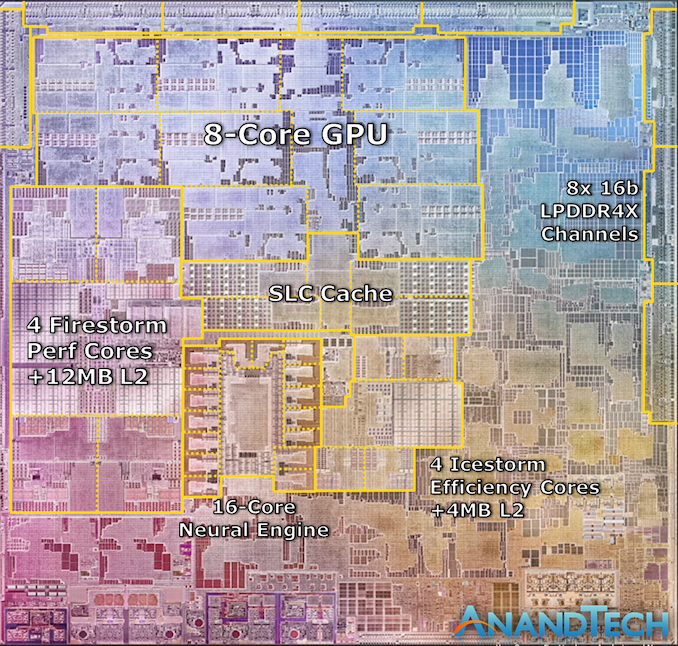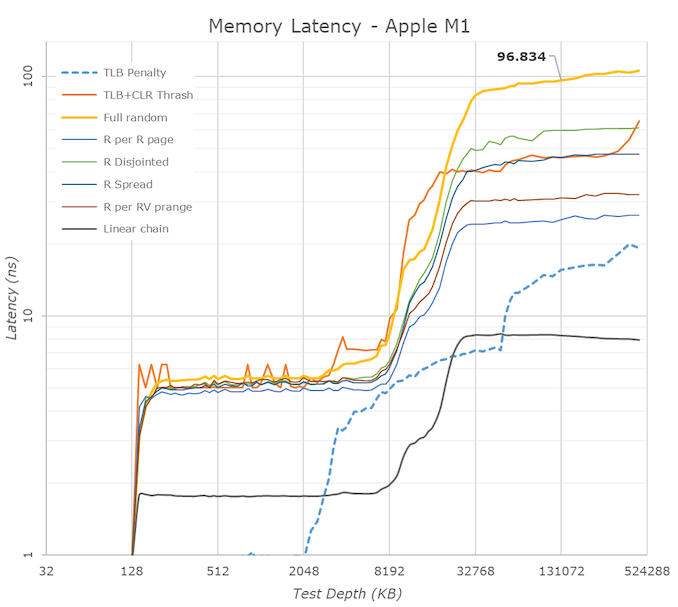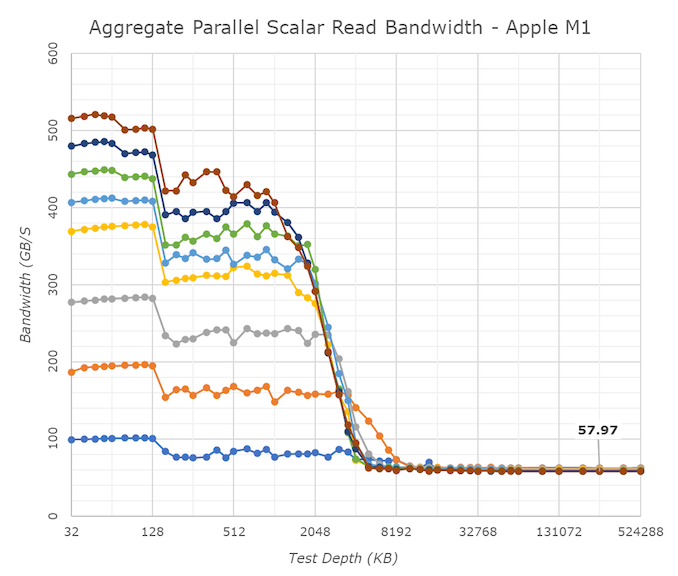The 2020 Mac Mini Unleashed: Putting Apple Silicon M1 To The Test
by Andrei Frumusanu on November 17, 2020 9:00 AM EST
Last week, Apple made industry news by announcing new Mac products based upon the company’s new Apple Silicon M1 SoC chip, marking the first move of a planned 2-year roadmap to transition over from Intel-based x86 CPUs to the company’s own in-house designed microprocessors running on the Arm instruction set.
During the launch we had prepared an extensive article based on the company’s already related Apple A14 chip, found in the new generation iPhone 12 phones. This includes a rather extensive microarchitectural deep-dive into Apple’s new Firestorm cores which power both the A14 as well as the new Apple Silicon M1, I would recommend a read if you haven’t had the opportunity yet:
Since a few days, we’ve been able to get our hands on one of the first Apple Silicon M1 devices: the new Mac mini 2020 edition. While in our analysis article last week we had based our numbers on the A14, this time around we’ve measured the real performance on the actual new higher-power design. We haven’t had much time, but we’ll be bringing you the key datapoints relevant to the new Apple Silicon M1.
Apple Silicon M1: Firestorm cores at 3.2GHz & ~20-24W TDP?
During the launch event, one thing that was in Apple fashion typically missing from the presentation were actual details on the clock frequencies of the design, as well as its TDP which it can sustain at maximum performance.
We can confirm that in single-threaded workloads, Apple’s Firestorm cores now clock in at 3.2GHz, a 6.66% increase over the 3GHz frequency of the Apple A14. As long as there's thermal headroom, this clock also applies to all-core loads, with in addition to 4x 3.2GHz performance cores also seeing 4x Thunder efficiency cores at 2064MHz, also quite a lot higher than 1823MHz on the A14.
Alongside the four performance Firestorm cores, the M1 also includes four Icestorm cores which are aimed for low idle power and increased power efficiency for battery-powered operation. Both the 4 performance cores and 4 efficiency cores can be active in tandem, meaning that this is an 8-core SoC, although performance throughput across all the cores isn’t identical.
The biggest question during the announcement event was the power consumption of these designs. Apple had presented several charts including performance and power axes, however we lacked comparison data as to come to any proper conclusion.
As we had access to the Mac mini rather than a Macbook, it meant that power measurement was rather simple on the device as we can just hook up a meter to the AC input of the device. It’s to be noted with a huge disclaimer that because we are measuring AC wall power here, the power figures aren’t directly comparable to that of battery-powered devices, as the Mac mini’s power supply will incur a efficiency loss greater than that of other mobile SoCs, as well as TDP figures contemporary vendors such as Intel or AMD publish.
It’s especially important to keep in mind that the figure of what we usually recall as TDP in processors is actually only a subset of the figures presented here, as beyond just the SoC we’re also measuring DRAM and voltage regulation overhead, something which is not included in TDP figures nor your typical package power readout on a laptop.

Starting off with an idle Mac mini in its default state while sitting idle when powered on, while connected via HDMI to a 2560p144 monitor, Wi-Fi 6 and a mouse and keyboard, we’re seeing total device power at 4.2W. Given that we’re measuring AC power into the device which can be quite inefficient at low loads, this makes quite a lot of sense and represents an excellent figure.
This idle figure also serves as a baseline for following measurements where we calculate “active power”, meaning our usual methodology of taking total power measured and subtracting the idle power.
During average single-threaded workloads on the 3.2GHz Firestorm cores, such as GCC code compilation, we’re seeing device power go up to 10.5W with active power at around 6.3W. The active power figure is very much in line with what we would expect from a higher-clocked Firestorm core, and is extremely promising for Apple and the M1.
In workloads which are more DRAM heavy and thus incur a larger power penalty on the LPDDR4X-class 128-bit 16GB of DRAM on the Mac mini, we’re seeing active power go up to 10.5W. Already with these figures the new M1 is might impressive and showcases less than a third of the power of a high-end Intel mobile CPU.
In multi-threaded scenarios, power highly depends on the workload. In memory-heavy workloads where the CPU utilisation isn’t as high, we’re seeing 18W active power, going up to around 22W in average workloads, and peaking around 27W in compute heavy workloads. These figures are generally what you’d like to compare to “TDPs” of other platforms, although again to get an apples-to-apples comparison you’d need to further subtract some of the overhead as measured on the Mac mini here – my best guess would be a 20 to 24W range.
Finally, on the part of the GPU, we’re seeing a lower power consumption figure of 17.3W in GFXBench Aztec High. This would contain a larger amount of DRAM power, so the power consumption of Apple’s GPU is definitely extremely low-power, and far less than the peak power that the CPUs can draw.
Memory Differences
Besides the additional cores on the part of the CPUs and GPU, one main performance factor of the M1 that differs from the A14 is the fact that’s it’s running on a 128-bit memory bus rather than the mobile 64-bit bus. Across 8x 16-bit memory channels and at LPDDR4X-4266-class memory, this means the M1 hits a peak of 68.25GB/s memory bandwidth.
In terms of memory latency, we’re seeing a (rather expected) reduction compared to the A14, measuring 96ns at 128MB full random test depth, compared to 102ns on the A14.
Of further note is the 12MB L2 cache of the performance cores, although here it seems that Apple continues to do some partitioning as to how much as single core can use as we’re still seeing some latency uptick after 8MB.
The M1 also contains a large SLC cache which should be accessible by all IP blocks on the chip. We’re not exactly certain, but the test results do behave a lot like on the A14 and thus we assume this is a similar 16MB chunk of cache on the SoC, as some access patterns extend beyond that of the A14, which makes sense given the larger L2.
One aspect we’ve never really had the opportunity to test is exactly how good Apple’s cores are in terms of memory bandwidth. Inside of the M1, the results are ground-breaking: A single Firestorm achieves memory reads up to around 58GB/s, with memory writes coming in at 33-36GB/s. Most importantly, memory copies land in at 60 to 62GB/s depending if you’re using scalar or vector instructions. The fact that a single Firestorm core can almost saturate the memory controllers is astounding and something we’ve never seen in a design before.
Because one core is able to make use of almost the whole memory bandwidth, having multiple cores access things at the same time don’t actually increase the system bandwidth, but actually due to congestion lower the effective achieved aggregate bandwidth. Nevertheless, this 59GB/s peak bandwidth of one core is essentially also the speed at which memory copies happen, no matter the amount of active cores in the system, again, a great feat for Apple.
Beyond the clock speed increase, L2 increase, this memory boost is also very likely to help the M1 differentiate its performance beyond that of the A14, and offer up though competition against the x86 incumbents.
- Page 1: Apple Silicon M1: Recap, Power Consumption
- Page 2: Benchmarks: Whatever Is Available
- Page 3: M1 GPU Performance: Integrated King, Discrete Rival
- Page 4: SPEC2006 & 2017: Industry Standard - ST Performance
- Page 5: SPEC2017 - Multi-Core Performance
- Page 6: Rosetta2: x86-64 Translation Performance
- Page 7: Conclusion & First Impressions













682 Comments
View All Comments
Nick B - Tuesday, November 17, 2020 - link
The M1 SoC is currently limited to 16GB of RAM. Mac Intel laptops currently offer 32 GB options, the iMac goes up to 128 GB, the iMac Pro maxes out at 256 GB.Apple is a multi-trillion dollar company because it executes consistently. Without a doubt SoC with additional TB4 ports and larger RAM capacity are coming. You'll just have to wait like the rest of us.
Nick B - Tuesday, November 17, 2020 - link
Not "right timing" but engineering and logistics capacity. And yes they have a desktop class version of the M1 that's been under development for as long as this M1. That's how engineering and business planning works. Apple is consistent at delivering products on schedule when they control the process from start to finish. M1 Macs will be no different.MrCrispy - Tuesday, November 17, 2020 - link
and by the time Apple releases a new chip next year, I assume you think Intel/AMD will have spent the year sleeping?M1/Apple Silicon is meant for mobile/laptop, not desktop. And when Zen3/4 come out and move to 5nm the perf gap and perf/watt gap will be very little.
Unless you think other companies don't have engineers or are run by idiots.
Spunjji - Thursday, November 19, 2020 - link
Apple's next release is likely to be around the end of Q1, maybe early Q2 next year.At that time, the AMD competitor will still be Zen 3 (with the addition of Cezanne on the mobile side of things) and the closest Intel competitor will be 8-core Tiger Lake, with Rocket Lake on desktop. It's hard to take the latter seriously as a competitor, though, as its power usage will be on a different order of magnitude.
That picture only changes significantly if it takes Apple until very late in 2021 or early 2022 to release a larger chip, in which case it might face off against Alder Lake. That would be more interesting as an outright performance comparison, but in power/performance terms it doesn't seem like Intel are likely to gain back much ground.
Spleter - Wednesday, November 18, 2020 - link
What are they doing? Intel, AMD, and Qualcomm are trying to sell designs marked up at a profit that OEM’s are willing to pay for, as in turn the OEM’s are out to produce their product that they hope to mark up at a good profit but face a situation of having to vend product that must run Windows to address as much potential customers as possible. The world of a WinTel OEM’s market is highly competitive and it seems most consumers and corporate IT purchase decision makers only view PC’s as simple commodities and so you just get an OEM race to the bottom in prices. Outside of creative pro’s and gaming enthusiasts, it seems the average WinTel consumer is not willing to pay what it takes for the PC industry/ecosystem toApple, on the other hand, does “the whole widget” and increasingly takes on the risk of in-house responsibility for design and production of critical components of their end product solutions. And since they are not trying to market those components as products that have to be individually marked up for sale, they only have to worry about one single profit objective. Apple only has to focus on what is technically needed to achieve performance targets for some user experience objective and can just fold in all the cost considerations together as they just pick a product price has their desired profit margin.
Intel, AMD, and Qualcomm don’t have enough mass market consumer demand for their highest end designs and must make chips that address many different OEM segment needs. In one since its easy to see what Apple is doing for performance with their big/wide SoC designs but will any OEM’s pay the price it takes to match Apples designs knowing that the may price themselves out of the market with end consumers? Qualcomm’s latest mobile chips are now bigger than ever and now more expensive than ever, could the price themselves out of some OEM markets trying to match Apple SoC performance? (Or is it that Microsoft, Intel, and Qualcomm take “too much” value out of their part of the end product such that there is not enough for OEM’s to really sustainable
Apple has the unit volumes and only makes what they need for their requirements, and they make their critical components the best they can be made at the time. Plus, Apple has the premium segment of the phone, mobile & desktop PC market with customers willing to pay for quality,
M1 is not some low cost
Spleter - Wednesday, November 18, 2020 - link
Wasn’t ready to submit that...M1 is not some low cost chip, it is the chip in Apples “low cost”/low end mobile PC offerings. M1 is the low power/high efficiency offering in the family of chips that will be based on this architecture.
This is the lowest end performance baseline SoC of the Mac Apple Silicon family. The real performance mobile/desktop workstation SoC will really reveal the performance chasm between x86 and Apple Silicon
km1810vm4 - Tuesday, November 17, 2020 - link
Any change of getting some compiler benchmarks? Building a toolchain or the Linux kernel?km1810vm4 - Tuesday, November 17, 2020 - link
*chance*dgb448 - Tuesday, November 17, 2020 - link
Not complete benchmarks, but early signs are that compiling is crazy fast.https://twitter.com/wvo/status/1328739313132077056
MoosBadda - Tuesday, November 17, 2020 - link
Wonder why the 16' MBP didn't get featured in the benchmark comparisons. I see a few people waiting to upgrade being very interested in that comparison.